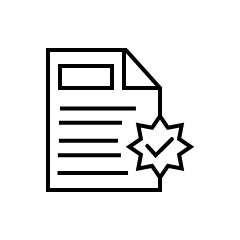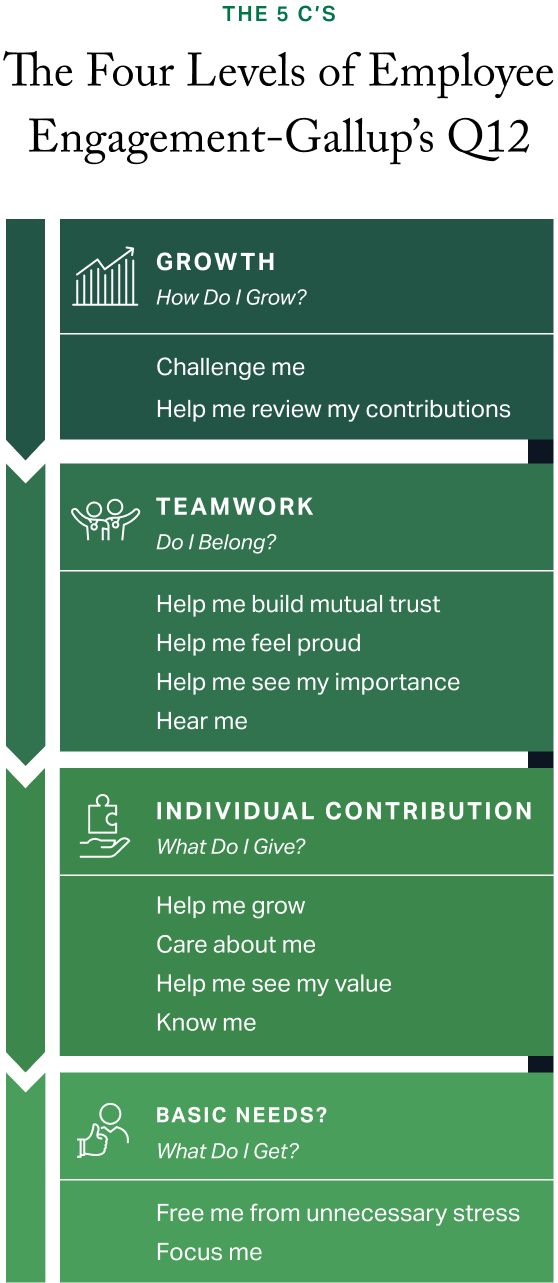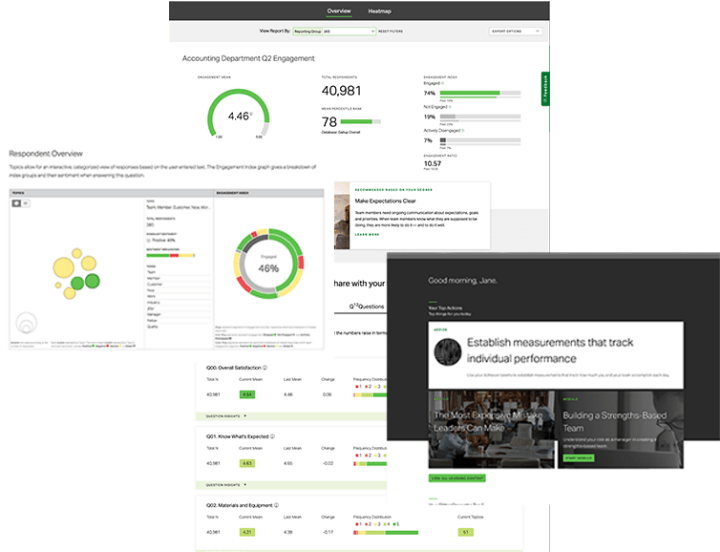What Is Employee Engagement and How Do You Improve It?
- Employee Engagement Definition
- Why Is Employee Engagement Important?
- Whose Job Is Employee Engagement?
- What Are the Drivers of Employee Engagement?
- Improving Employee Engagement Strategies
- Measuring Employee Engagement: Gallup's Questions
- The Employee Engagement Model
- Employee Engagement Examples: The 3 Types of Employees You Have
- How to Improve Employee Engagement: Team Engagement Ideas
- Improving Employee Engagement Begins Here
01 Employee Engagement Definition
Gallup defines employee engagement as the involvement and enthusiasm of employees in their work and workplace.
Employee engagement helps you measure and manage employees' perspectives on the crucial elements of your workplace environment.
You can find out if your employees are actively engaged with their work or simply putting in their time. You can discover if your team-building activities and human resources practices influence positive business outcomes or if there's room to grow.
And with the right approach, you can learn how to improve your employees' connection to their work and your company and how to avoid employee burnout.

02 Why Is Employee Engagement Important?
Employees make decisions and take actions every day that can affect your workforce and organizational effectiveness.
The way your company treats employees and how employees treat one another can positively affect their actions -- or can place your organization at risk.
Based on decades of employee engagement research, Gallup knows that engaged employees produce better business outcomes than other employees -- across industry, company size, and nationality, and in good economic times and bad.
But only 23% of employees worldwide and 31% in the U.S. fall in the "engaged" category.
So, what can companies do better to engage employees?
When companies use Gallup's Q12® as a framework to improve employee engagement -- one that executives support as a primary management strategy -- they yield clear and better results.
Asking, "Why is employee engagement important?" is a vital question for leaders to consider. Employee engagement has many benefits; without employee engagement, there's no team engagement, making it more difficult to improve business outcomes.
When Gallup analyzed the differences in performance among business/work units, the benefits of employee engagement were clear. When comparing employee engagement levels, Gallup found that top- and bottom-quartile business units and teams had the following differences in business outcomes*:
*The above figures are median percent differences across companies in Gallup's database. High-turnover organizations are those with more than 40% annualized turnover. Low-turnover organizations are those with 40% or lower annualized turnover.
03 Whose Job Is Employee Engagement?
Employee engagement starts at the top of an organization. Highly engaged workplaces have executive leaders who buy into, communicate and model engagement, creating the conditions for managers and employees to adopt an engagement mindset.
Once executives are committed, managers are essential to engagement. In fact, 70% of the variance in team engagement is determined solely by the manager.
Employee engagement should be a manager's primary responsibility.
Managers are in charge of ensuring that employees know what work needs to be done, supporting and advocating for them when necessary, and explaining how their workplace engagement connects to organizational success.
To succeed in that responsibility, managers need to be equipped to have ongoing coaching conversations with employees.
Unfortunately, most managers don't know how to make frequent conversations meaningful, so their actions are more likely to be interpreted as micromanaging without providing the right tools and direction.
So, it's not enough for leaders to simply tell managers to own engagement and coach their teams.
Leaders must:
- communicate the importance of engagement
- build trust in the benefits of engagement
- model engaging behaviors
- redefine managers' roles and expectations
- provide the training tools, resources and development that managers need to coach and meet those expectations
- create evaluation practices that help managers accurately measure performance, hold employees accountable and coach to the future
04 What Are the Drivers of Employee Engagement?
One of the most common mistakes companies make is to approach engagement as a sporadic exercise in making their employees feel happy -- usually around the time when a survey is coming up.
It's true that we describe engaged employees as "enthusiastic." And employee engagement surveys play a big role in measuring staff engagement. But it's not that simple.
These are the key drivers of employee engagement:

purpose

development

a caring manager

ongoing conversations

a focus on strengths
Employees need more than a fleeting warm-fuzzy feeling and a good paycheck (even if it helps them respond positively on employee engagement survey questions) to invest in their work and achieve more for your company.
People want purpose and meaning from their work. They want to be known for what makes them unique. This is what drives employee engagement.
And they want relationships, particularly with a manager who can coach them to the next level. This is who drives employee engagement.
One of Gallup's biggest discoveries: The manager or team leader alone accounts for 70% of the variance in team engagement.


05 Improving Employee Engagement Strategies
Nearly 80% of employees worldwide are still not engaged or are actively disengaged at work, despite more effort from companies.
The greatest cause of a workplace engagement program's failure is this: Employee engagement is widely considered "an HR thing."
Many executive-level leaders have not embraced engagement in a way that communicates its importance to employees and holds managers accountable for its deployment.
The result is that some organizations believe they have exhausted "engagement" as a performance lever before they truly explore its full potential to change their business.
These leaders consistently experience low engagement, or they plateau and eventually decline -- despite repeated attempts to boost scores. Other times, they have high engagement numbers, but their business results tell a different story.

At a loss for explanations, leaders may blame the tool, the measurement, the philosophy or environmental factors that they believe make their problems unique.
But, the apparent failure of employee engagement efforts is likely because of how organizations implement workplace employee engagement programs. Some common mistakes:
Too complicated.
Leaders make engagement metrics far too complicated by focusing on predictors that are often outside managers' control and typically don't relate to meeting employees' core psychological needs at work.
Incorrect employee engagement metrics.
They use a low-bar "percent favorable" metric that inflates scores and creates blind spots, resulting in the appearance of high engagement without strong business performance outcomes.
Overuse of surveys.
They overuse pulse surveys to get immediate feedback and rarely take action on the results.
In contrast, leaders who have integrated engagement into their corporate strategy using the framework we outline in the next section on this page see significant gains year after year.
06 Measuring Employee Engagement: Gallup's Questions
Gallup has identified 12 elements of employee engagement that predict high team performance. These 12 elements make up our Q12 survey.
Managers can take charge of engagement by asking and evaluating their employees' responses to these 12 employee engagement questions to create a structure for their interactions with employees -- casual conversations, meeting agendas, performance evaluations and team goal setting.
We've been measuring and reporting employee engagement trends for years and have used the 12 elements to determine how involved and enthusiastic employees are in their work and workplace.
The 12 Elements
Some of the 12 elements might seem simple. But Gallup's employee engagement research has found that only a small percentage of employees strongly agree their employer or manager delivers on them.
Here are three employee engagement ideas to help managers approach each element:

Q01. I know what is expected of me at work.
Helping employees understand what their organization, leaders and managers expect from them requires more than someone telling them what to do. The most effective managers define and discuss each employee's explicit and implicit expectations. They paint a picture of outstanding performance and help employees recognize how their work leads to the success of their coworkers, their business area and the entire organization.

Q02. I have the materials and equipment I need to do my work right.
"Materials and equipment" is not just a checklist of tools. It includes both tangible and intangible resources -- office supplies, software, knowledge sharing and permissions, to name a few -- that employees need to do their job. The most effective managers don't assume what their team needs. They ask for and listen to their employees' needs and advocate for them when necessary. They also find ways to make the most of their team's ingenuity and talents when they cannot fully fund requests.

Q03. At work, I have the opportunity to do what I do best every day.
When people get to do what they do best every day at work, the organizations they work for get a boost in employee participation, attraction, engagement and retention. Successful managers get to know their employees as individuals and give them opportunities to apply the best of their natural selves -- their talents. They talk to each employee about their unique value and make adjustments to align work, when possible, with team members' talents. The best managers know where their employees excel and position them so that they are engaged and provide maximum value to the organization.
Increasing Employee Engagement Post-Survey
An engagement survey is only the first step to motivating employees. If you implement a survey with no follow-up, engagement will likely decrease.
To gain positive momentum and increase engagement, you must ask for feedback, do something about it and continually share results.
Using employee engagement software is a great place to start. Many engagement platforms offer helpful action items and advice for leaders and managers looking to increase team engagement. Using these resources can help build accountability.
07 The Employee Engagement Model
There are four levels in the employee engagement model.
This four-level hierarchy is based on four types of employees' performance development needs:


Meeting the needs in the three foundational levels creates an environment of trust and support that enables managers and employees to get the most out of the top level -- personal growth.
These levels provide a road map for managers to motivate and develop their team members and improve the team members' performance, with each one building on the previous.
The levels do not represent phases. Managers do not "finish" the first level and then move on to the second level. They must ensure that employees know what is expected of them and have the right materials and equipment to do their work while meeting needs on the second, third and fourth levels.
With their team members, managers should identify needs and obstacles on an ongoing basis and ideally take action before challenges inhibit their employees' performance.
Interested in using our Q12 survey? Learn more about our employee engagement platform, Gallup Access, here.
Learn More About Gallup's Employee Engagement Survey: Ask the Right Questions With the Q12® Survey

08 Employee Engagement Examples: The 3 Types of Employees You Have
Engaged
Engaged employees are highly involved in and enthusiastic about their work and workplace. They are psychological "owners," drive high performance and innovation, and move the organization forward.
Example: An employee who logs in for a few hours longer to get a project over the finish line or who spends more time on the phone with a client who needs help -- because they're committed to their organization's "client first" values. They build up their coworkers and have strong relationships within the organization.
Not Engaged
Not engaged employees are psychologically unattached to their work and company. Because their engagement needs are not being fully met, they're putting time -- but not energy or passion -- into their work.
Example: An employee who completes their work but is fueled by duty rather than passion or personal interest. This employee may prefer to fly under the radar and might back down from more intense or high-profile work.
Actively Disengaged
Actively disengaged employees aren't just unhappy at work -- they are resentful that their needs aren't being met and are acting out their unhappiness. Every day, these workers potentially undermine what their engaged coworkers accomplish.
Example: This employee spends their time talking negatively about coworkers, current projects, leaders, etc. They may be searching for other employment opportunities in their spare time and do not plan to stay at their current job much longer.
09 How to Improve Employee Engagement: Team Engagement Ideas
There are no quick fixes when it comes to human relationships. Simple employee engagement activities won't transform your culture.
But since the value of the Q12 items is in helping managers and teams start conversations and approach workforce engagement issues authentically and meaningfully, there are lots of ideas in the framework to help you build your team up.
For example:
Addressing Diversity and Inclusion
A new manager has inherited a low-performing team with diverse ages, genders, cultures and personalities. After a few months of private conversations and tense team meetings, she can tell that a lack of cooperation and disunity are at the heart of the team's lack of collaboration and low performance outcomes.
Addressing Hybrid Work
For hybrid work to be effective long term, we must consider the real benefits and risks. Push yourself to look beyond management practices that worked when people were mostly on-site or are simply more comfortable because they're familiar. Instead, assess how you can modify those practices to align with your commitment to hybrid and remote workers.
Engagement areas for manager action:
Q04 Receiving frequent recognition:
Make recognition a regular agenda item to demonstrate appreciation for individuals' different contributions to the team and organization. Metrics and methods of tracking excellence should transcend location. If teams are working flexibly, managers have to understand performance management and culture in a flexible way.
Q05 Someone cares about me:
Ask employees: What would make you feel like a valued team member? Individualize the approach to leading team members based on how they say they want to be treated.
Q07 My opinions count:
Become an advocate for employees' ideas. Solicit them during meetings and take action on them.
10 Improving Employee Engagement Begins Here
Partner with Gallup to bring the best out of your employees.


For Departments and Organizations Learn about our employee engagement solutions and customized plans for organizations. Connect with a Gallup expert to talk through your employee engagement goals, employee engagement best practices and access to our platform -- Gallup Access (home to the Q12 survey) -- and discover how a partnership with us could look.
We recommend this option for departments in organizations with more than 100 employees.
For Smaller Teams and Organizations Purchase a one-time Q12 survey. Get limited access to our platform for 12 months.
We recommend this option for teams and organizations with fewer than 100 employees.